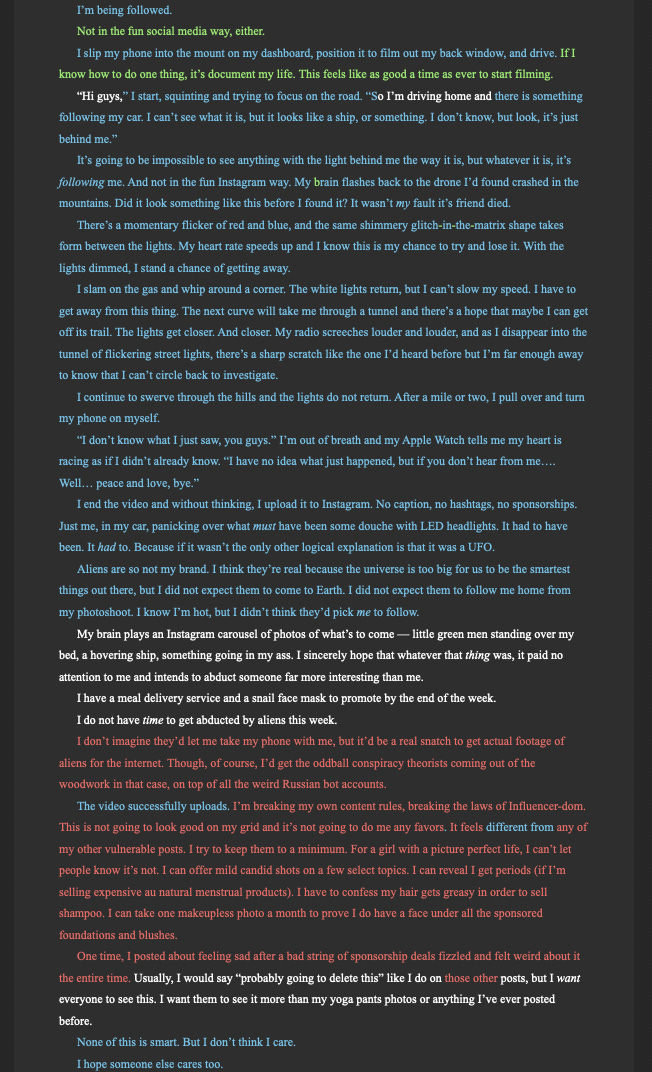reduce, reuse, revise
revising and recycling are similar because you really just want to throw things away
Last week, I did the very exciting task of turning in my first round of revisions on Love and Other Conspiracies! It was my first real writer deadline, of many more, I hope, and I am genuinely super proud of the work I’ve put into this book, especially this current revision.
(Did you know you can also add Love and Other Conspiracies on Goodreads if you haven’t already?? Currently sitting pretty at a perfect 5 stars, just to appreciate this now since it will not last)
Earlier this fall/winter, I thought it’d be no big deal to revise two projects at once (L&OC and my prospective Book 2). I planned to revise both during NaNo November and get the second off to beta readers in December. That did not happen. Nor did the other goal I set for the end of the year.
With one project out of the way, I plan to dive head first into revisions on Hopefully Book 2, which we’ll call MIBWIP for now.
I genuinely didn’t know how to revise until I did Kiss Pitch last year. As a teenager, I wrote book after book, and tossed them off to my friends. I assumed if there were just a spare few typos, it was fine. When I started getting more critical feedback as I got older, I was quick to say “ok well, I didn’t write it to be that way, so… what do you want me to do?” and was very beholden to the idea that if something doesn’t come out right the first time, it’s not meant to be.
That is incredibly inaccurate, at least in my case.
I’ve gotten used to accepting that my first drafts will not be perfect. In fact, they’ll probably be raging dumpster fires.
Me, sending my book to betas:
Something has to exist before it can become the best form of itself. Sometimes a draft has to be full of brackets yelling [OH MY GOD FIX THIS IT’S HORRIBLE] or a personal favorite from MIBWIP: [TK SOME ASSHOLE SOUNDING LAST NAME]. Sometimes you write a scene and your only option is to shout “We’ll fix it in Post!” and move on.
When I first got serious about revisions for L&OC, I felt really intimidated. A bunch of friends were using the Susan Dennard method, which requires what feels like an entire cipher key and code language that I sensed would not work for my brain. And of course because my brain does not allow me a single moment of peace, I presumed it was because I was too stupid and my books were too shallow and bad.
I was also an idiot who swore a reverse outline would not do anything for me because my brain didn’t work that way either (it does, and I am a huge fan of a reverse outline now). But I think what it’s all taught me is that everyone is going to have a different process and it’s going to work differently for every person and even from a book to book basis.
Here is what the revision process for MIBWIP has looked like so far. Draft 1 of this book came in at about 75k and I am currently at 96k after beefing it up, for reference.
Initial Pass — I usually go back through once I’ve finished my zero draft and clean up. Sometimes it involves amending scenes, other times it’s as simple as filling in brackets I left behind for myself. It’s where I take the book from a fiery garbage pile and make it just a regular garbage pile.
Theme Brainstorming — this was something that I learned during Kiss Pitch and has been incredibly helpful to use in all my projects. When I got my edit letter from my mentor, she emphasized that the big theme in L&OC is believing and that’s the motif I needed to carry through the book. So “believe” became that core word and it suddenly made the entire book click into place. Everything tied back to a central theme and it made my scenes far more connected and pointed. For MIBWIP, one of my CPs aptly zeroed in on the fact that the theme for this book was “care”. Both Carter and El are characters who don’t have a strong circle of people around them to take care of them, and because of that, so much of what draws them together are the ways they can care for one another.
Reverse Outline - I break the book down scene by scene and the below columns are the ones I am using for this particular project:
My plot column is definitely heavy on the mystery element of this book, while the romance columns help me make sure there’s something plotty and romance-y happening at the same time in each scene. Using this helps me keep track of how long it’s been since a certain theme or arc has popped up. With my core theme in mind, I sort of comb through the whole book and figure out where I can lace it in better. Sometimes I don’t adhere to it as much when I go back and revise, however, it gets my head in the right lens to look at a story in a certain way.
Scrivener Revision Mode — With MIBWIP in particular, I’ve been revising on and off for a while, so it hasn’t been as straightforward of a process, but one of the most satisfying tools is Revision Mode in Scrivener. I love seeing all the different colors for each pass and seeing how my writing has grown. I find that revision 1 (red) tends to be filling in empty spaces. Revision 2 (blue, which I did kind of a small revision with, mostly at the end) helps me thicken up the story and make corrections, and Revision 3 (green) has been making it all effective. I predict there will be probably another pass or two before I migrate over to Word and work from there. An example of what a page looks like right now:
I think one of the most important parts of revising is finding trusted beta readers and critique partners who will help you get your book where you need it to be. It can take time to find those people who give you good feedback, and who you trust. For MIBWIP, I’ve been sharing chapter by chapter with my weekly critique group. I had a similar situation with L&OC, too. It’s helpful to have people steer you in the right directions as you go.
I’m hopefully going to send MIBWIP to beta readers in a couple weeks (I plan to be ready to do so by my birthday. So I have… a little over a week. Woo!) I think the other most critical part of revising is feedback and knowing how to take it and when to take it. In most cases, beta readers are there to help you and are probably eager to read your book. Unless you want a straight positivity pass, they will find things for you to fix. It doesn’t mean your book is bad and beyond saving. The benefit is that you now have people on your side to help you make it better!
Of course, there’s always the chance of getting a bad beta who either doesn’t get your book at all (maybe it’s not for them, maybe in a genre they don’t have a ton of experience reading or writing etc.) so, in those cases, I think it’s worthwhile to take was resonates and leave what doesn’t. You will never please everyone and you will also likely have ten different streams of feedback and they will not all line up. In those cases, I look for the common threads and begin to work with those first.
Some people will just be assholes and zero help. We discard those beta readers, with good reason.
I am so excited to get this book into some beta inboxes because it’s not really like anything I’ve ever written before. I am eager but nervous to know if it’s WAY too out of the box and odd, or if it makes zero sense at all (I think it makes some sense).
But even if it’s not fully there yet, needs to be scaled back, or rewritten completely, hey, that’s what revising is for!
And now, for our obligatory cryptid meme:






I'm a firm believer of reverse outlining too! It's time consuming, but helps more than I thought possible.
That Scrivener page looks so cool. I'm so tempted to get a Windows based computer just to buy it.